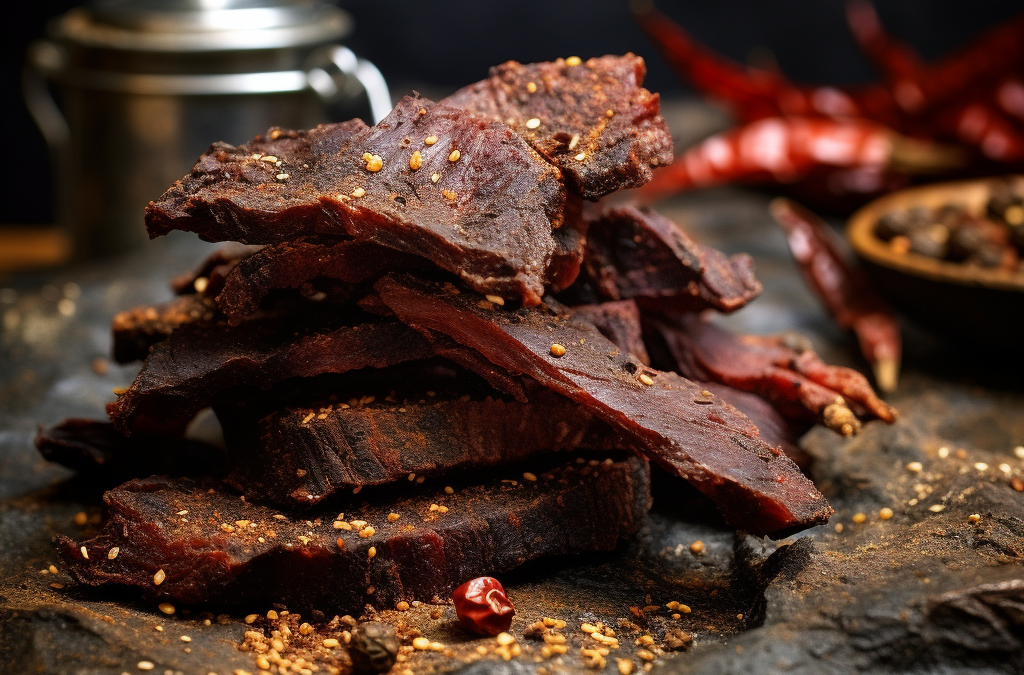Biltong, a savory snack hailing from the vibrant landscapes of South Africa, has captured the taste buds of food enthusiasts around the globe. This article is a deep dive into the world of biltong, exploring its origins, traditional preparation methods, and cultural significance. We’ll also draw comparisons between biltong and its American counterpart, beef jerky, highlighting the differences in taste, texture, and nutritional value. Whether you’re a curious foodie, a seasoned traveler, or a culinary connoisseur, this exploration will provide valuable insights into selecting, enjoying, and making your own biltong. Join us as we uncover this South African delicacy’s rich history and unique characteristics.
Discovering Biltong: A South African Delicacy
This beloved snack transcends the ordinary, crafted from not only beef but also game and other meats. The art of biltong-making begins with the meat being carved into generous strips, then seasoned with a signature spice blend that often includes coriander, black pepper, and a splash of vinegar, infusing it with a distinctive flavor that’s deeply rooted in its South African heritage. Click here for premium biltong meat.
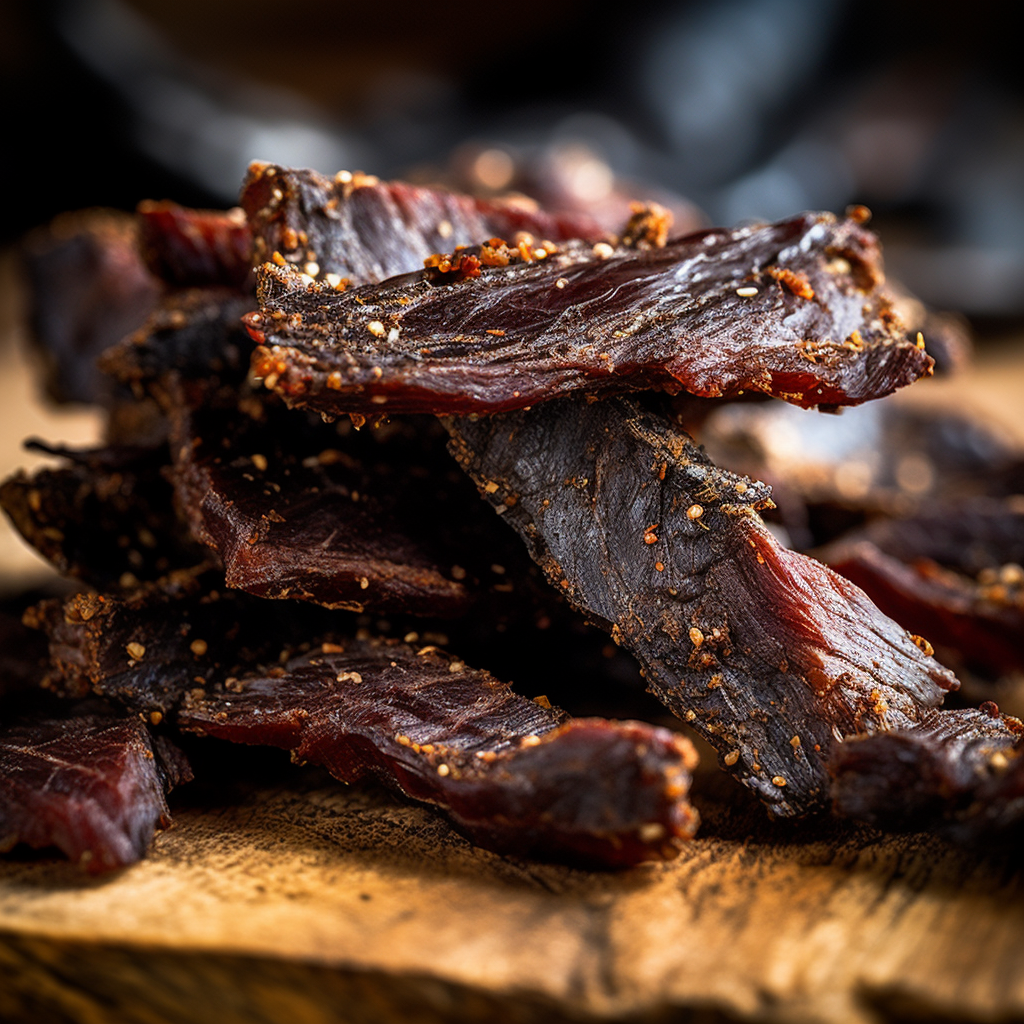
The magic of biltong unfolds during its air-drying phase, which is carried out in cooler conditions, sometimes with the assistance of subtle air movement. This leisurely drying process is pivotal for nurturing its unique texture and rich flavor profile, yielding a more succulent product than many jerkies, with a moisture level that varies according to regional tastes or individual preferences.
Biltong is woven into the cultural tapestry of South Africa, with a lineage tracing back to the indigenous tribes who pioneered meat preservation through salting and drying. The Dutch settlers, or Voortrekkers, later embraced these techniques during their expansive treks, securing a reliable food source. Today, biltong is a testament to South Africa’s history of innovation and endurance.
Biltong’s versatility shines in the culinary realm, where it can be savored in its unadulterated form or used to elevate a variety of dishes with its hearty flavor. Whether it’s shredded atop a simmering stew, tossed into a fresh salad, or paired with a selection of cheeses, biltong infuses a slice of South African tradition into any culinary creation.
As you delve into the world of biltong, you’re not just sampling a new snack; you’re partaking in a rich cultural narrative. With its robust taste and storied background, this South African specialty captivates the palates of gastronomes and history enthusiasts alike, offering a taste of South Africa’s enduring spirit.
Definition and Preparation of Biltong
What is Biltong?
Biltong is a distinctive cured meat, typically crafted from beef or wild game. It’s meticulously sliced in alignment with the muscle grain into strips that strike the perfect balance between thickness and width, ensuring even drying without compromising texture.
The initial step in biltong preparation is a vinegar bath, which imparts a tangy zest and acts as a gentle preservative. This stage sets the stage for the meat’s signature tang. The seasoning phase follows, with a liberal application of a traditional spice mix that often includes coarsely ground coriander, black pepper, and occasionally brown sugar to counteract the vinegar’s sharpness and add depth to the flavor profile. The meat is then left to marinate, allowing the intricate blend of spices to fully permeate the meat, a process that can span several hours to an entire night.
In contrast to other cured meats, biltong eschews smoking in favor of air-drying. Post-marination is suspended in a controlled environment where humidity and temperature are carefully regulated to prevent spoilage and encourage a gradual curing process. This drying period can extend from a few days to weeks, tailored to the desired dryness level and influenced by the ambient conditions.
Once fully cured, biltong emerges as a concentrated medley of flavors, its texture both firm and tender, offering a delectable contrast between the seasoned exterior and the succulent interior. This traditional South African delicacy has evolved with modern curing techniques to ensure safety while honoring its time-honored appeal. The meticulous attention to detail throughout the biltong-making process underscores its significance as not just a snack but a treasured element of South African gastronomy.
The Historical Roots of Biltong
Tracing its origins to the indigenous peoples of Southern Africa, biltong’s legacy began with the Khoisan, who mastered the art of drying meat to endure the harsh, arid climate. This preservation technique was essential in a region where the relentless heat threatened the longevity of fresh provisions. When Dutch settlers arrived in the 17th century, they encountered this ingenious method and quickly integrated it into their culinary practices.
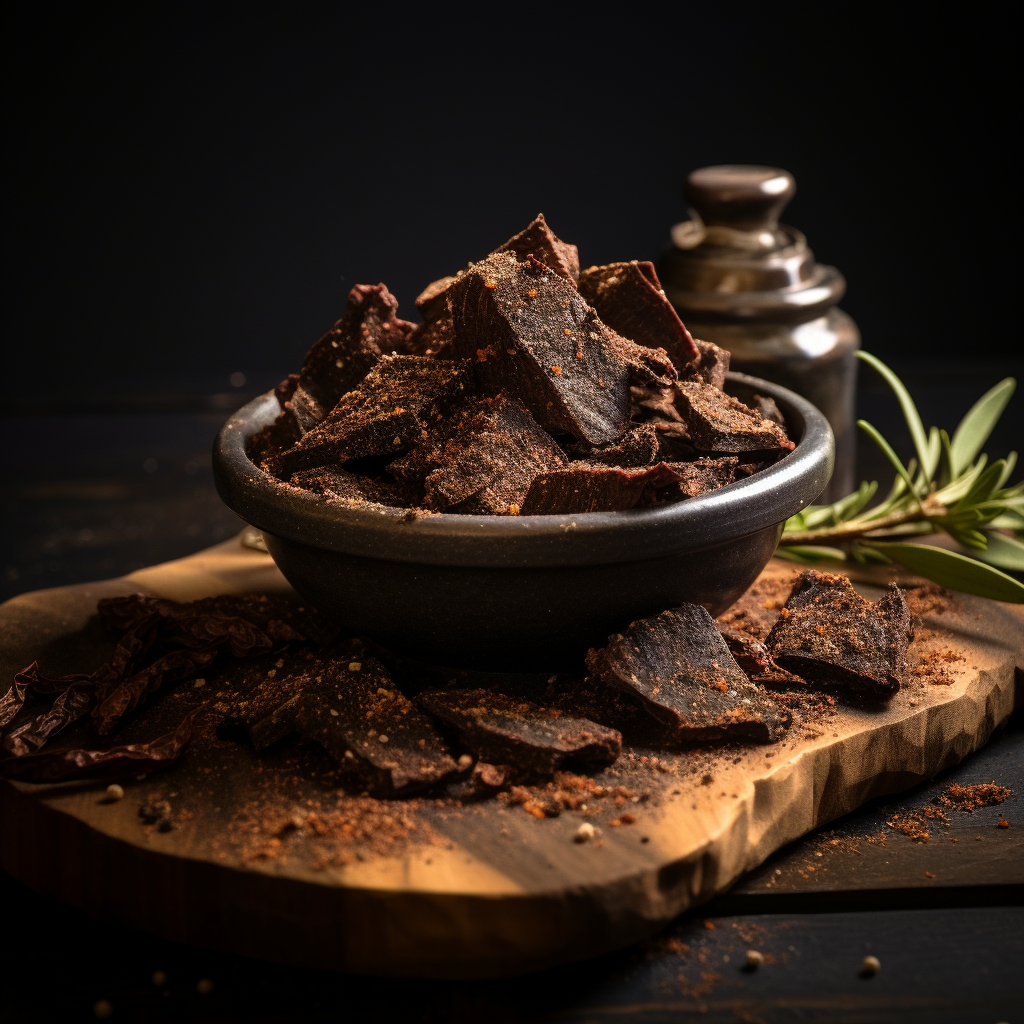
The term biltong itself is a nod to its preparation, combining the Dutch words bil (rump) and tong (strip or tongue) to describe the product’s form. The Voortrekkers, Dutch pioneers who ventured across the African subcontinent, relied heavily on this nourishing fare during their expansive treks. The integration of vinegar, a staple for preservation and tenderization, along with the aromatic addition of spices like coriander, was a testament to the settlers’ adaptation and the influence of the global spice trade.
The beauty of biltong lies in its simplicity: no need for refrigeration or complex apparatus, just a space to cure the meat with sufficient airflow. This ease of preparation allowed its popularity to soar, making it an everyday staple among various communities, from pastoralists to adventurers.
As South Africa’s society flourished, the biltong tradition held steadfast, eventually emerging as a commercial delight enjoyed worldwide. Despite its global reach, the fundamental techniques of crafting biltong have stood the test of time, honoring the rich history from which it sprang.
Biltong today stands as a culinary emblem, a testament to South Africa’s innovative spirit in the face of adversity. It celebrates human ingenuity in food preservation, a practice as old as civilization itself.
Cultural and Historical Significance
Biltong is woven as a symbol of resilience and unity in the tapestry of South African heritage. It transcends its role as a snack, encapsulating tales of survival and adaptation from indigenous tribes and European settlers. Biltong’s presence in South African life is ubiquitous, accompanying moments of joy and camaraderie, from sporting events to family feasts, reinforcing communal ties with every shared bite.
Crafting biltong is a cherished tradition, often handed down through family lines, linking present and past in a continuous culinary thread. Its integration into many dishes—from hearty stews to innovative pizzas—speaks to its versatility and entrenched status within the nation’s cuisine.
Biltong has also played a part in unifying the diverse South African populace, with various ethnic groups putting their unique spin on the classic recipe. This adaptability mirrors the inclusive and evolving nature of the country’s cultural landscape.
Historically, biltong’s curing method was a forerunner to contemporary food preservation, showcasing the timeless human quest to extend the shelf life of perishable goods. It stands as a testament to the cross-cultural practice of meat curing, which has been pivotal in the gastronomic narratives of societies worldwide.
As South Africans ventured beyond their borders, biltong traveled with them, gaining international acclaim and morphing into a global phenomenon. This spread reflects the diaspora’s influence, introducing biltong to new audiences and allowing it to flourish in diverse culinary scenes.
The enduring appeal of biltong, both within South Africa and abroad, underscores the profound impact that food can have in shaping national identity and fostering global connections.
Biltong Versus Beef Jerky
When exploring the realm of dried meats, biltong and beef jerky often emerge as two beloved snacks. Despite their shared category, they diverge in preparation, taste, and texture, each bearing the hallmark of their unique heritage and culinary techniques.
Differences in Taste and Texture
Embarking on a sensory journey, one discovers that biltong offers a distinctively tangy and spiced palate experience, a tribute to its South African origins. The meat, which can range from beef to game, is infused with a vinegar-based marinade and seasoned with spices such as coriander, creating a bold and nuanced flavor. The air-drying process, which can span from days to weeks, allows for a spectrum of textures, from a tender chewiness to a more robust, leathery bite.
Conversely, beef jerky presents a contrasting profile with its smoky sweetness resulting from a marinade rich in soy sauce, sugar, and a variety of spices. This American classic is crafted from lean beef cuts and dried at a low, consistent heat, culminating in a uniformly dry and chewy texture. The jerky’s pronounced flavors and firmer consistency set it apart from the more malleable and subtly moist biltong.
These divergent characteristics of biltong and beef jerky cater to different taste preferences and reflect the cultural diversity encapsulated in these two popular snacks.
Nutritional Aspects and Culinary Uses
Biltong and beef jerky are both celebrated for their high protein content and minimal carbohydrate levels, aligning perfectly with the dietary preferences of those on ketogenic or other low-carb diets. They are packed with essential amino acids, the building blocks for muscle repair and growth, which is why fitness enthusiasts and those seeking satiating, protein-dense snacks often reach for these options.
Nutritionally speaking, biltong may boast a slight advantage. Its traditional preparation involves air-drying, which typically eschews the need for added sugars or artificial preservatives. This method, which employs salt, vinegar, and a blend of spices, not only imparts a unique flavor but also helps preserve the meat’s natural nutrients, including iron and B vitamins. In contrast, beef jerky’s preparation often includes sweeteners and a variety of flavorings, which can elevate the sodium and sugar content, thus affecting its overall nutritional profile.
In the culinary realm, biltong’s adaptability shines through in its integration into South African dishes. It’s a treat enjoyed on its own or can be shredded to enhance soups and salads with its rich flavor. Biltong can also be a hearty addition to stews or a savory twist in baked delights like the beloved biltong bread. Its umami quality makes it a prized component in both home and professional kitchens.
While beef jerky is more typically consumed as a standalone snack in North America, it too can be a creative culinary ingredient. It can be diced into a trail mix for a savory note or serve as a robust flavor enhancer in various recipes. However, its more intense marinated flavor and firmer texture mean it’s less frequently utilized as a versatile kitchen staple compared to biltong.
Both snacks offer nutritional value and culinary versatility, but consumers and chefs should consider their distinct characteristics when incorporating them into meals or choosing them as part of a health-conscious diet.
Selecting and Enjoying Biltong
Venturing into the world of Biltong involves a keen eye for quality and an appreciation for the subtleties that define this South African treat. The art of selection is paramount in unlocking the full pleasure of biltong.
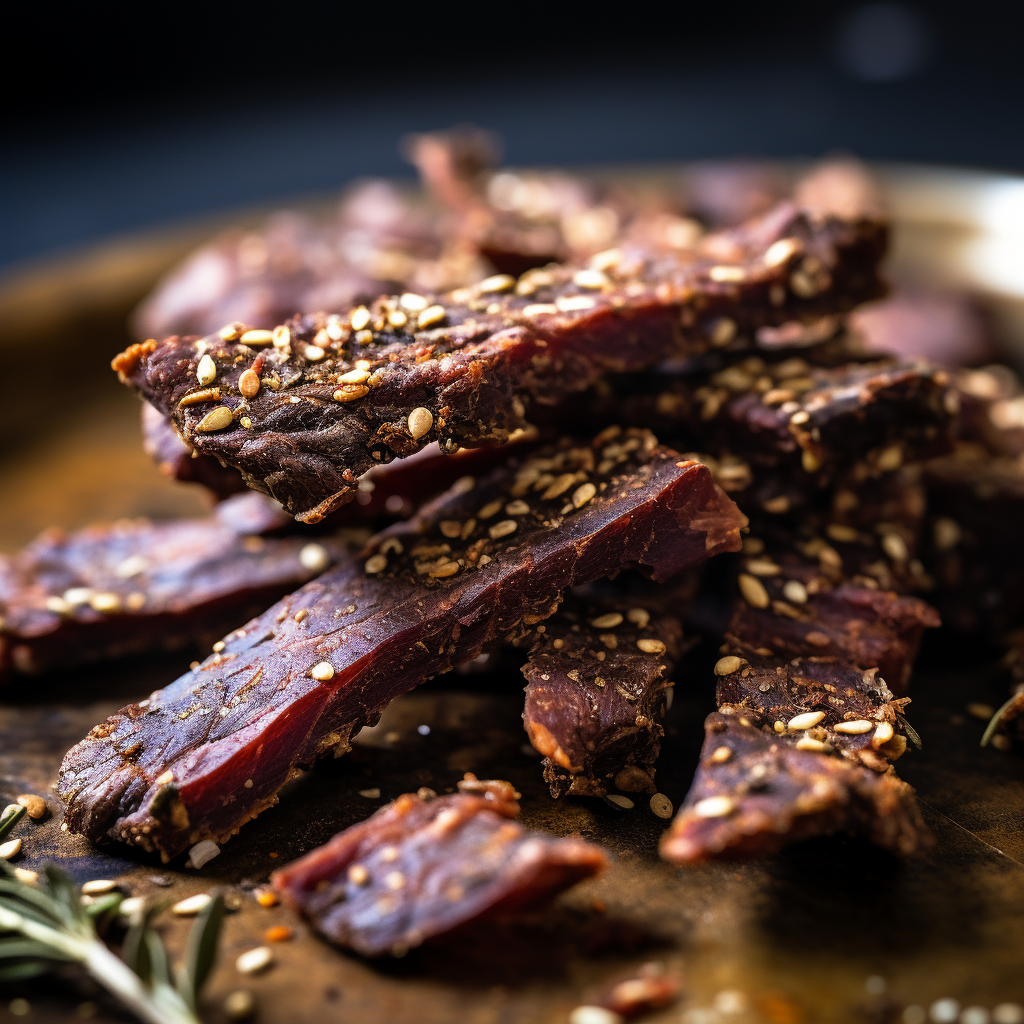
Tips for Selecting High-Quality Biltong
The journey to exceptional biltong starts with premium meat. When choosing, pay attention to the meat type; traditional biltong is made from beef or game, with beef being more widely available. Seek out biltong that boasts a deep, uniform hue and a texture that indicates careful drying without being overly desiccated.
The meat’s cut also plays a crucial role. The silverside or topside cuts are often favored for their lean yet tender qualities. While a certain degree of marbling is desirable for its contribution to flavor and tenderness, an excess of fat may detract from the overall experience.
Freshness is a telltale sign of superior biltong. It should exude a fresh, tangy aroma with a hint of the spices used in its cure, such as coriander and black pepper, without any off-putting odors. The flavor profile should be robustly meaty with a balanced acidity from the vinegar.
Storing Biltong for Optimal Enjoyment
Proper storage is essential to preserve Biltong’s distinct taste and texture. A cool, dry environment is ideal to ward off mold. While refrigeration can extend its life, it may also dry the meat further, potentially altering its texture. For those who prefer their biltong more tender, room temperature storage in a paper bag or a container that allows airflow is advisable for a brief period. Vacuum sealing and freezing are viable methods for longer preservation without significantly diminishing the quality.
Biltong can be savored in its simplest form or as part of a more elaborate culinary creation. It’s a popular on-the-go snack or an accompaniment to drinks, but it can also be sliced thin and paired with cheese and crackers for an elegant appetizer. In true South African fashion, biltong is often enjoyed with a local beer or a glass of Pinotage, enhancing the rich flavors of the meat.
Whether indulging in a casual nibble or featuring it on a sophisticated charcuterie board, appreciating the finer points of biltong selection and storage will undoubtedly enrich your experience with this savory-cured delicacy.
Making Your Own Biltong at Home
Embarking on the journey of crafting biltong within the comfort of your kitchen is an endeavor that marries the art of patience with the science of curing. With its unique preparation process, this South African specialty can be a delightful project for those with a penchant for homemade delicacies.
Essential Ingredients and Simple Equipment
To commence your biltong-making adventure, procuring quality ingredients and assembling basic equipment are paramount. Begin with a selection of premium beef cuts such as sirloin, topside, or silverside, known for their lean quality and robust flavor. The marination process calls for vinegar—apple cider or malt varieties are preferred for their traditional zing.
Crushed coarse salt draws out moisture and enhances the meat’s natural savoriness during the curing stage. Aromatic coriander seeds and black peppercorns, toasted and crushed, impart the quintessential biltong flavor. While these are the staples, feel free to introduce brown sugar for a hint of sweetness, bicarbonate of soda for tenderization or other spices to align with your palate.
As for equipment, simplicity is key. A sharp knife ensures precise cuts of meat, while a large bowl or marinating tray serves as the vessel for your curing concoction. The drying phase can be achieved in a homemade biltong box or any well-ventilated space shielded from pests. Hooks or stainless steel skewers are the final pieces of the puzzle, providing the means to suspend the meat strips as they embark on their transformation.
In the following section, we’ll delve into the meticulous steps of the biltong preparation process, guiding you through from the initial cut to the final product. With these essentials at hand, you’re well on your way to creating a snack that’s both a nod to tradition and a reflection of your culinary creativity.
The Biltong Preparation Process
Embarking on the journey of making biltong is an art that blends precision with personal touch. Here’s a step-by-step guide to crafting this savory treat:
- Trimming and Cutting: Start with a lean cut of beef, trimming away any excess fat to ensure even drying. Slice the meat into uniform strips, about one inch in thickness. Consider the meat’s grain when cutting; slicing with the grain yields a chewier texture, while going against the grain offers a more tender bite.
- Marinating: Submerge the strips in a vinegar bath, which not only tenderizes the meat but also creates an acidic barrier against bacteria. A few hours should suffice, but some enthusiasts recommend an overnight soak for deeper flavor infusion.
- Seasoning: Once marinated, blot the meat dry. Coat each strip with a robust blend of coarse salt, cracked coriander, and black pepper, ensuring even coverage. This stage is to get creative by introducing additional spices to suit your palate.
- Curing: Set the seasoned meat aside to cure, a crucial step where flavors meld and drying commences. The duration of this phase can range from a few hours to a whole night, depending on your desired intensity of flavor and texture.
- Drying: Transfer the meat to a prepared drying area, suspending the strips for optimal air circulation. This is essential to achieve uniform drying and to ward off any potential mold.
- Monitoring: Regularly inspect the meat during the drying phase, looking for signs of spoilage or uneven drying. The process may span 2 to 5 days, influenced by environmental conditions and the thickness of your cuts.
- Testing for Readiness: Press the meat with your finger to gauge its dryness. The ideal biltong should be firm yet yield slightly under pressure, with some pliability. Your preference for dryness will ultimately dictate the perfect moment to conclude the drying.
- Slicing: Once you’ve achieved the desired dryness, it’s time to slice the biltong. Cut it into bite-sized morsels for easy snacking, or keep the strips long for a more rustic, hands-on experience.
The craft of biltong-making is a customizable adventure, allowing you to infuse your own flair at various stages. Whether it’s a signature spice blend or a meticulously chosen drying point, homemade biltong reflects your unique tastes.
Craft Your Own Biltong with Premium Meat From We Speak Meat
Our Beef Biltong Meat is meticulously sourced from the bottom round section, known for its lean texture and robust beefy flavor. This cut is particularly favored for biltong-making due to its ability to dry evenly while retaining a tender chewiness and depth of flavor that’s essential for an authentic biltong experience.
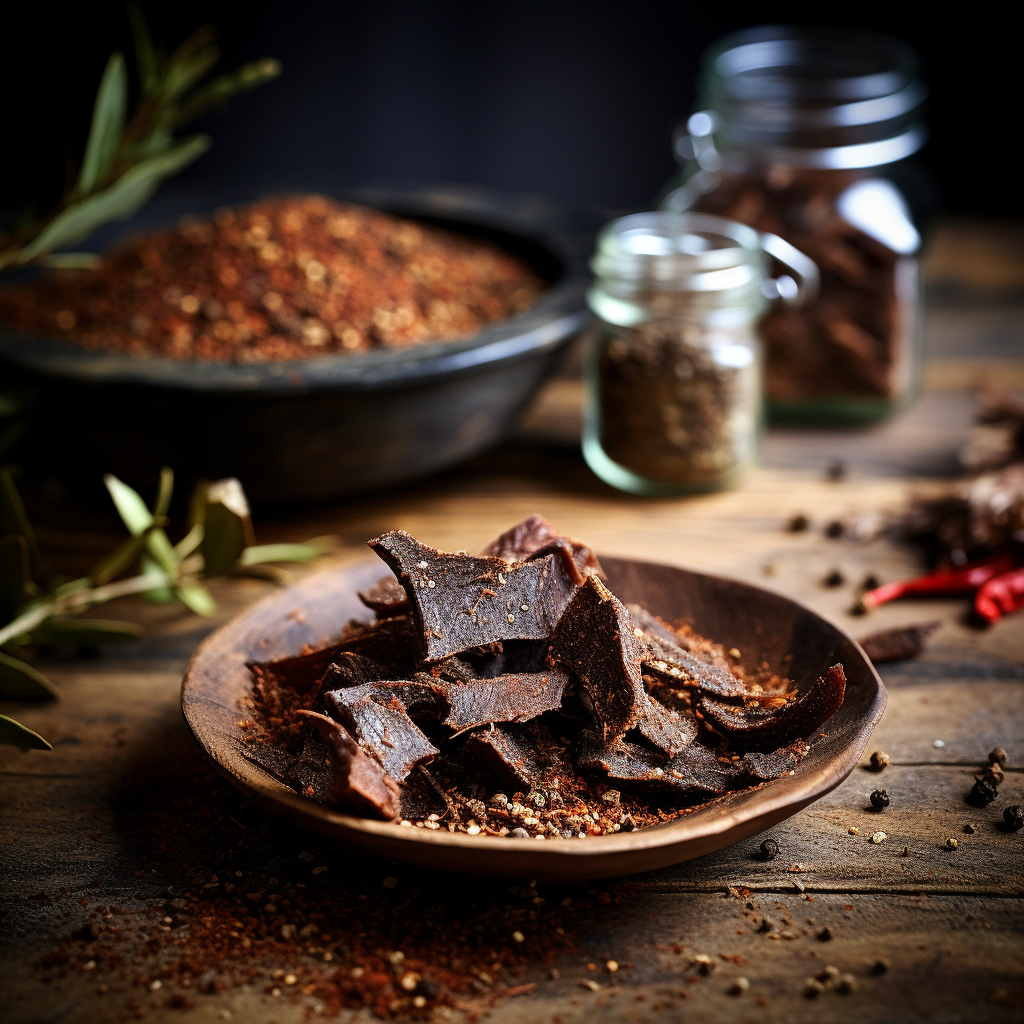
A Cut Above: The Ideal Base for Your Biltong Creations
The process of making biltong starts with the right cut of meat. Our biltong meat is expertly prepared, ensuring it’s ready for your personal touch. We provide the canvas; you bring your culinary artistry. Whether you adhere to traditional South African seasoning methods or choose to explore a variety of spice combinations, our Beef Biltong Meat is versatile and receptive to your individual palate.
Quality You Can Trust for the Ultimate Biltong Experience
At We Speak Meat, we understand that the quality of the biltong heavily relies on the quality of the meat used. That’s why we take immense care in selecting and preparing our Beef Biltong Meat. We ensure that each cut meets our stringent standards of quality, flavor, and texture. When you choose our biltong meat, you’re choosing a product that promises excellence in every aspect.
Bringing the Biltong Tradition to Your Kitchen
With our Beef Biltong Meat, you’re not just purchasing a cut of meat; you’re stepping into a rich tradition of food preparation. Whether you’re a seasoned biltong maker or just starting out, our meat is the perfect ingredient to help you explore this delicious culinary tradition. Perfect for snacking, sharing with friends, or as a thoughtful homemade gift, our Beef Biltong Meat is a must-try for any DIY enthusiast or lover of dried meats.
Discover our pre-spiced biltong, Rancher’s secret blend of the best spices, and un-spiced biltong options in the shop at our consistently low prices!

